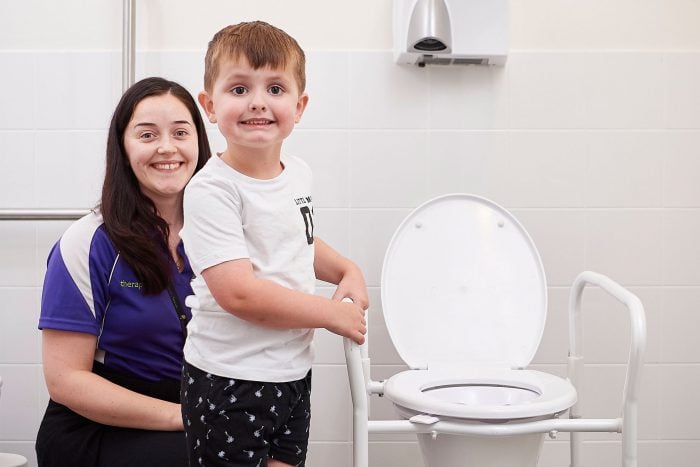What is LEGO-Based therapy?
LEGO-Based Therapy is a social development program that uses LEGO activities to support the development of a wide range of social skills within a group setting.
LEGO-Based Therapy was developed in the mid-1990s by US paediatric neuropsychologist Daniel LeGoff. He was inspired by watching two of his customers with Autism Spectrum Disorder play with LEGO in his waiting room and displaying previous non-demonstrated positive social interactions.
While initially developed for Autistic children, LEGO-Based Therapy has since been found to benefit children with a variety of communication and social developmental difficulties.
What are the benefits of LEGO-Based Therapy?
Playing with LEGO in a therapy setting promotes social interaction, turn-taking skills, sharing, collaborative problem-solving and the learning of concepts. It can be used to target goals around social skills, language and motor skills. By using a commonly adored tool like LEGO it capitalises on its existing motivation and supports self-esteem by allowing the participants to demonstrate their skills in a social situation. It also sets up a positive opportunity for guided social problem-solving to help develop social skills that can then be used in other situations.
Autistic children sometimes find it challenging to understand what is expected of them in a social situation, particularly within unstructured play activities. LEGO-Based Therapy provides a highly structured environment where everyone plays a specific role within the group. This can help Autistic children feel calm and relaxed as they are doing something that they enjoy and know precisely what to expect and what is expected of them.
At Therapy Focus, we regularly host LEGO-Based Therapy groups to help our customers work towards their goals. We usually call them LEGO Club.
What happens during a LEGO-Based Therapy session?
During a LEGO-Based Therapy session, three or four children of similar ages and abilities work together to build a LEGO model following.
Each child takes on one of four specific roles to do this:
- The Engineer oversees reading and relaying the instructions. The Engineer must tell the Supplier what pieces to retrieve and tell the Builder how to build the model.
- The Supplier oversees finding the correct LEGO pieces. The Supplier must listen to the Engineer and figure out what piece to retrieve, and then given these pieces to the Builder.
- The Builder oversees physically building the model. The Builder must listen to instructions provided by the Engineer and receive the pieces that are retrieved by the Supplier.
- The Foreman makes sure everyone is doing what they need to do. They provide help to other roles when needed and look out for social challenges that may need problem-solving by the group.
Using this format provides each child with an opportunity to practice and develop a wide range of skills, including language skills (in both giving and receiving instructions) turn-taking, negotiating, sharing and collaborative social problem-solving. It also encourages children to reflect on their own actions and skills as well as give constructive feedback to their peers.
Can you do LEGO-Based Therapy at home?
Absolutely! Dust off some of those LEGO sets and get the family involved with LEGO Therapy at home.
Do not have any LEGO sets at home? That is okay! If you have random LEGO bricks search ‘simple LEGO builds’ on Google, and you’ll be provided with a range of different things to build.
Two, three, or four people can join in this activity with each person taking on a fun role!
Playing with three people:
- First, choose someone to be the Engineer. This person will be the gatekeeper of the LEGO project (the instruction booklet). The other members of the group are not allowed to see the project book. This means The Engineer will need to use their communication skills to describe the pieces needed and how to put them together.
- The Engineer provides instructions to both the Supplier and the Builder.
- The Engineer will describe the size, shape, colour, how many pieces, and how many bumps the LEGO pieces need.
- The Engineer will provide instructions for how to build the project. For example, the Engineer could say “Put the white piece in the middle of the blue roof” if you were building a house.
- Second, choose someone to be the Supplier. This is a pivotal role in the world of construction.
- The Supplier is responsible for ensuring that they have the correct pieces of LEGO for the Builder.
- The Supplier can ‘check-in’ with the Engineer by showing them the LEGO piece and confirming it is correct.
- If it is correct, they pass it to the Builder.
- If it is incorrect, the Supplier can ask for more information from the Engineer.
- Finally, choose someone to play the most coveted role in the project – the Builder.
- The Builder is responsible for building the project.
- The Builder listens to instructions provided by the Engineer for building.
- The Builder must work with the Engineer to ensure what they are building is the same as what is in the project booklet.
Playing with two people.
- If there are only two of you, one person can take on two roles. For example, one person may be the Supplier and Builder and the other person the Engineer.
Playing with four people.
- If you have four people, then the Foreman role can be introduced. The Foreman makes sure the team are working together to build their project. This person can share encouraging words, compliment others, or help someone with their role.
Get in touch
At Therapy Focus, we have a team of experienced therapists who can provide support for neurodivergent people. Our team is here to help you achieve your goals.





















